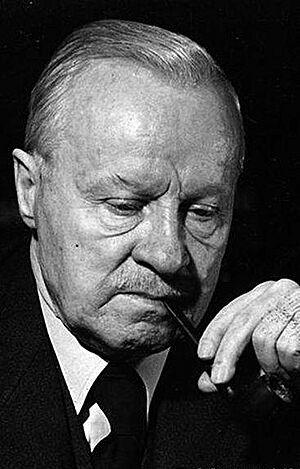Väinö Tanner facts for kids
Quick facts for kids
Väinö Tanner
|
|
|---|---|
 |
|
| 10th Prime Minister of Finland | |
| In office 13 December 1926 – 17 December 1927 |
|
| President | Lauri K. Relander |
| Preceded by | Kyösti Kallio |
| Succeeded by | Juho Sunila |
| Minister of Foreign Affairs | |
| In office 1 December 1939 – 27 March 1940 |
|
| Prime Minister | Risto Ryti |
| Preceded by | Eljas Erkko |
| Succeeded by | Rolf Witting |
| Minister of Finance | |
| In office 22 May 1942 – 8 August 1944 |
|
| Prime Minister | Johan W. Rangell Edwin Linkomies |
| Preceded by | Mauno Pekkala |
| Succeeded by | Onni Hiltunen |
| In office 12 March 1937 – 1 December 1939 |
|
| Prime Minister | Aimo Cajander |
| Preceded by | Juho Niukkanen |
| Succeeded by | Mauno Pekkala |
| Minister of Trade and Industry | |
| In office 3 July 1941 – 22 May 1942 |
|
| Prime Minister | Johan W. Rangell |
| Preceded by | Toivo Salmino |
| Succeeded by | Uuno Takki |
| Personal details | |
| Born | 12 March 1881 Helsinki, Russian Empire |
| Died | 19 April 1966 (aged 85) Helsinki, Finland |
| Resting place | Hietaniemi Cemetery |
| Political party | Social Democratic |
| Spouse | Linda Anttila |
| Children | 8 |
Väinö Alfred Tanner (1881–1966) was an important leader in Finland. He was a key figure in the Social Democratic Party of Finland, which is a political party. He also helped start and lead the cooperative movement in Finland. This movement helps people work together to buy and sell things. Väinö Tanner even served as the Prime Minister of Finland from 1926 to 1927.
Contents
Early Life and Education
Väinö Tanner was born in Helsinki, Finland, on March 12, 1881. His father worked on the railway and did not have much money. Väinö went to Ressu Upper Secondary School and finished in 1900.
After high school, he studied at a business college called Suomen Liikemiesten Kauppaopisto. He also studied law and became a jurist (a legal expert) in 1911.
Starting the Cooperative Movement
While still a student, Väinö Tanner worked as a trainee in Germany. In 1903, he returned to Finland and became the manager of Turun Vähäväkisten Osuusliike. This was the biggest cooperative shop in Finland at the time.
He later became a leader in other important cooperative groups. He was the CEO of Elanto from 1915. He also led the International Co-operative Alliance (ICA) from 1927 to 1945. This shows how important he was in helping people work together in business.
Political Career and Leadership
Väinö Tanner did not take sides during the Finnish Civil War. After the war, he became a top politician for the Social Democratic Party (SDP). He strongly believed in the parliamentary system, where people vote for their leaders.
His biggest success was helping the SDP become strong again after the Civil War. He showed that the party could be trusted to lead the country.
Key Government Roles
Väinö Tanner held many important jobs in the Finnish government:
- Prime Minister (1926–1927)
- Minister of Finance (1937–1939 and 1942–1944)
- Minister of Foreign Affairs (1939–1940)
- Minister of Trade and Industry (1941–1942)
His government made important changes, like making it easier for people who had been in trouble during the Civil War to get a fresh start. They also lowered taxes on food and created laws for pensions and health insurance.
Role in Wartime Finland
During a time when President Relander was sick, Tanner stepped in as acting president and even led a parade of the White Guards. This was a big deal because it showed how much trust he had gained.
In the 1930s and 1940s, the Social Democrats often worked with another party, the Agrarian party, to form governments. During the Winter War, Väinö Tanner was the foreign minister. He played a very important role in uniting the country and creating the "Spirit of the Winter War," which helped Finland stand strong.
After the Wars
After the Continuation War ended, Väinö Tanner faced a special trial in 1946 about his role during the war. He was given a prison sentence.
Even while in prison, Tanner remained a powerful figure in the SDP. He helped lead a group within the party that had strong support from the United States. This group eventually became very influential.
Tanner did not agree with Finland's post-war policy of staying neutral and being very friendly with the USSR. He returned to the Finnish parliament in 1951. He even became the chairman of the SDP again in 1957.
Väinö Tanner won his last election as SDP chairman in 1960. He left parliament in 1962 and stepped down as chairman in 1963. He was the last person in the Finnish parliament who had been elected in Finland's very first parliamentary election in 1907. He was also one of only four Finnish politicians who ran for president three times but never won.
Because he disagreed with the post-war policy, his relationship with future President Urho Kekkonen became very difficult. When Tanner passed away in 1966, President Kekkonen did not attend his funeral.
Personal Life
Väinö Tanner met his future wife, Linda Anttila, in 1907. They started living together in 1909 and officially got married in 1918 after civil marriage became legal in Finland. They had eight children together. One of their daughters, Maija Taka, became a medical doctor and a writer.
Cabinets
- Tanner Cabinet

